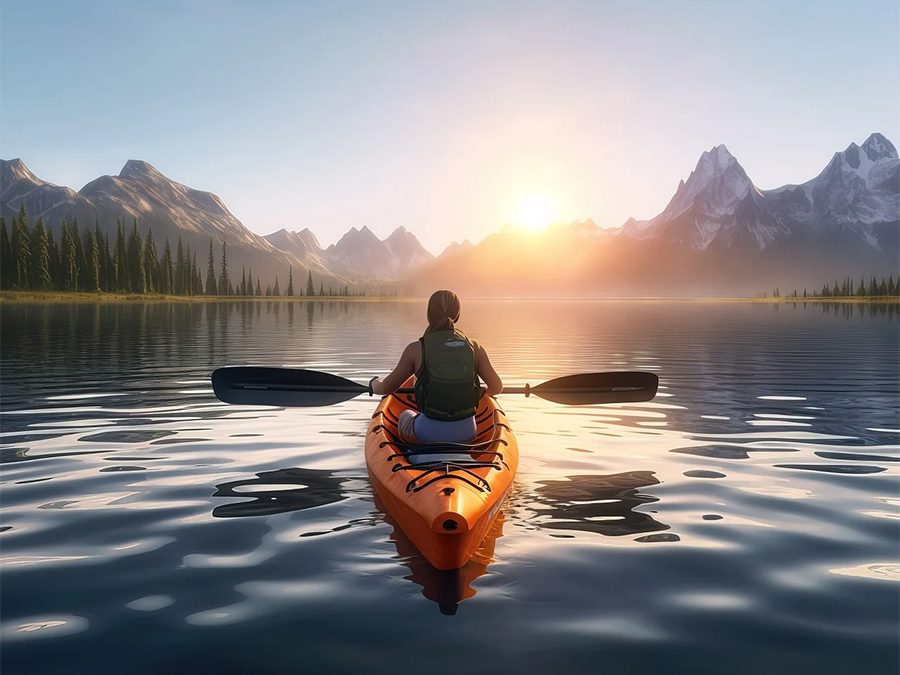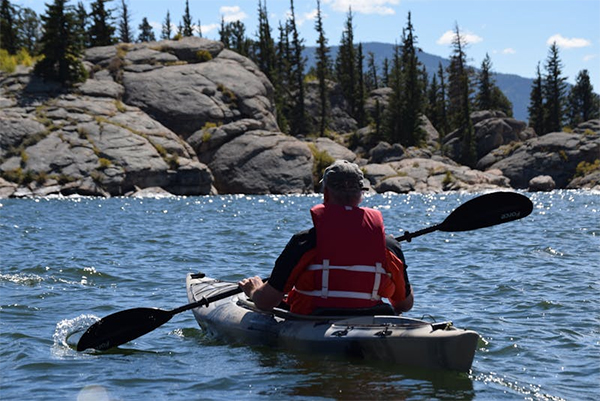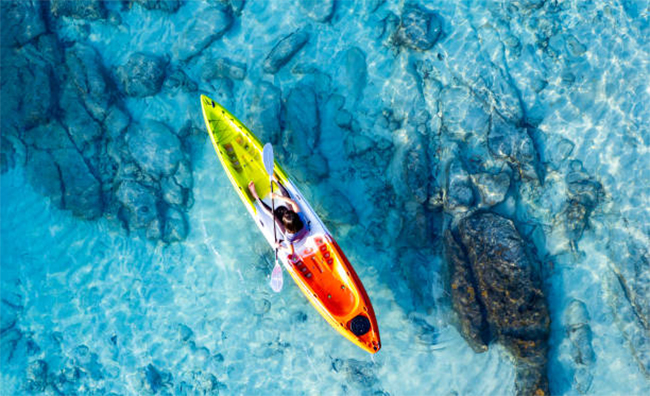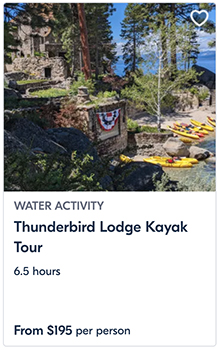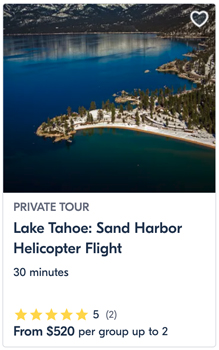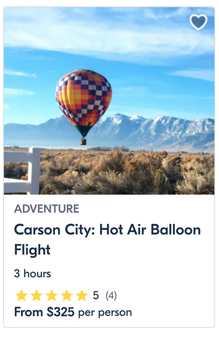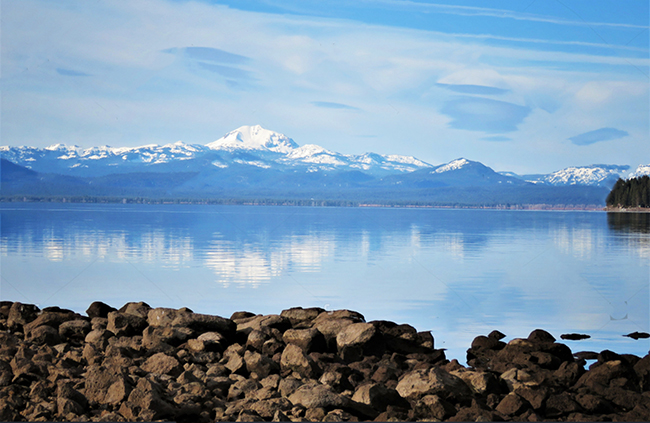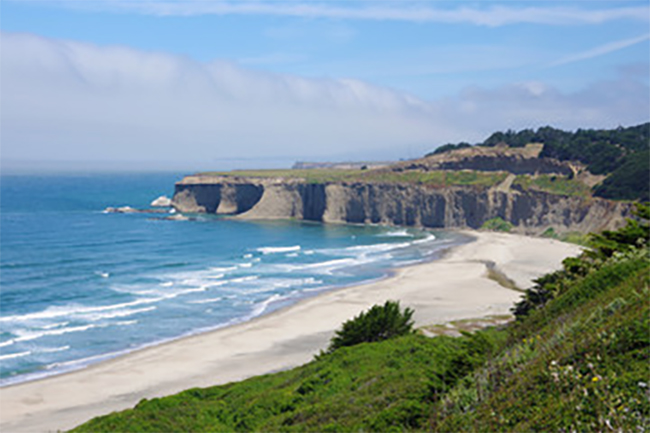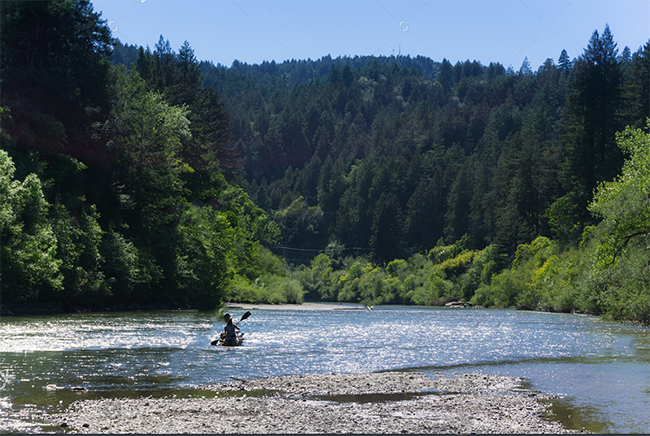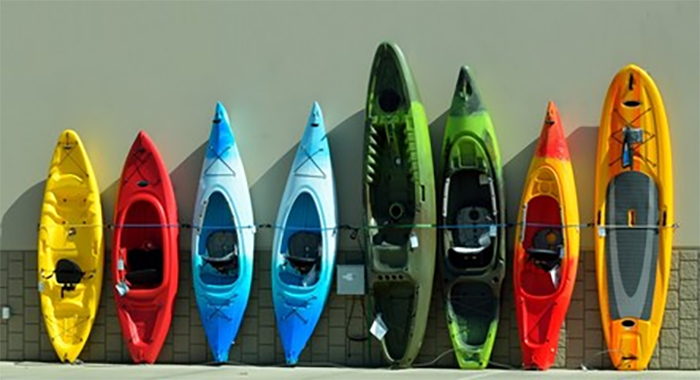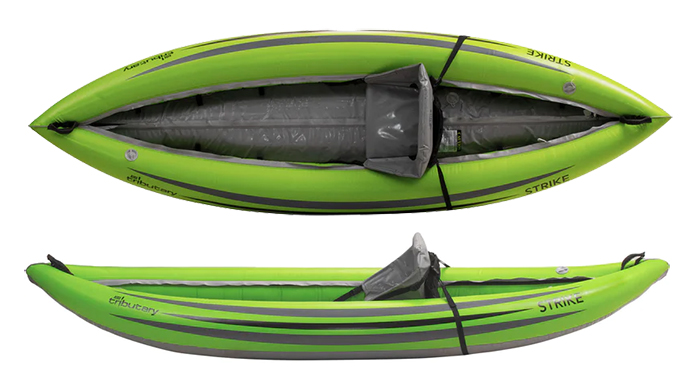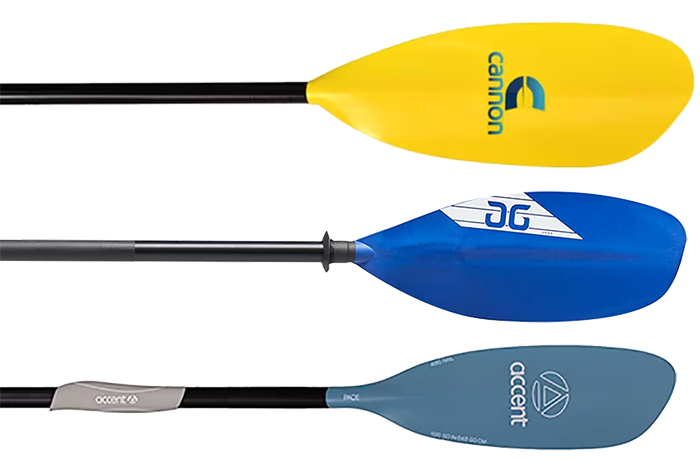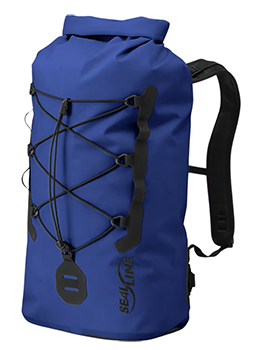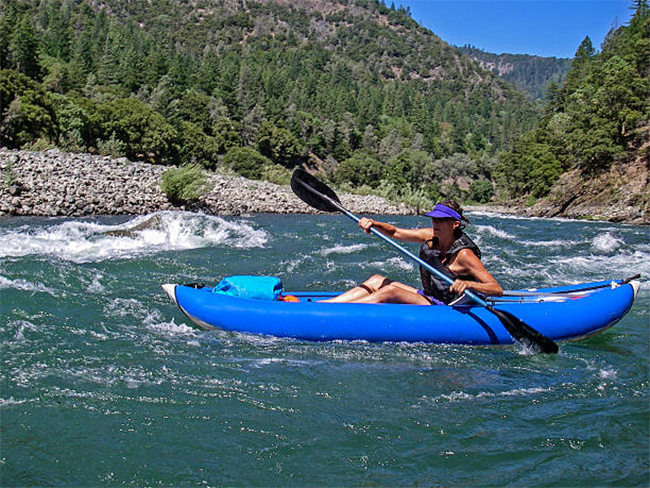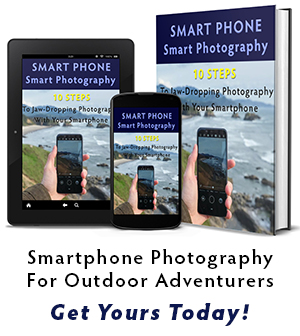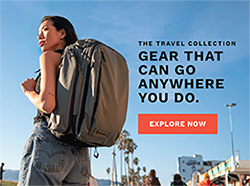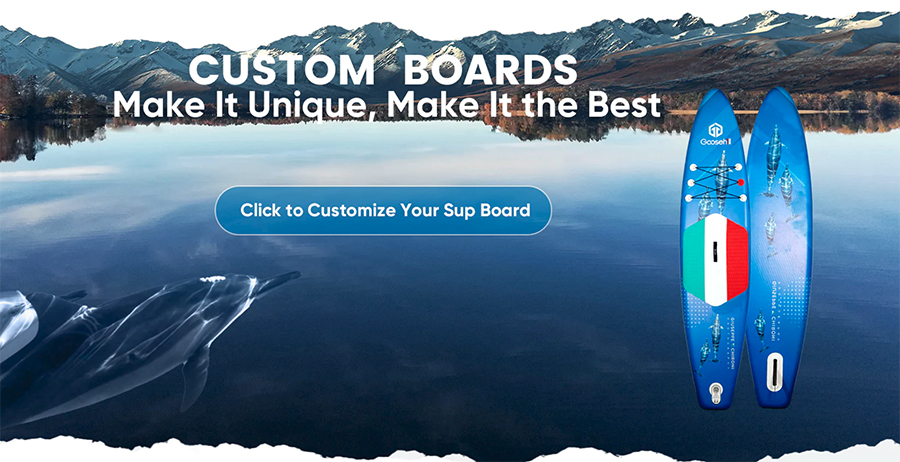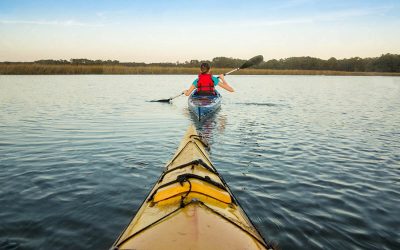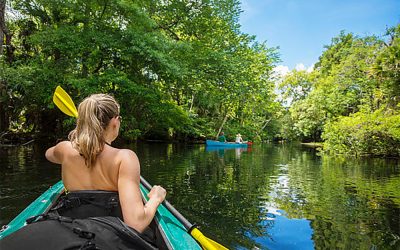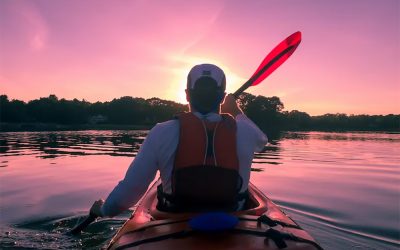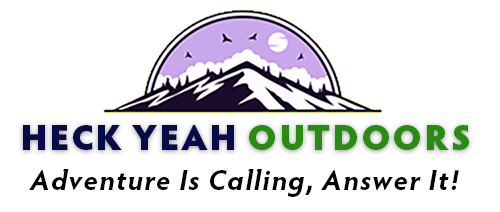The Best Places To Kayak In Northern California Navigating Nature's Wonders
Embarking on a kayaking adventure along the pristine waters of Northern California offers an unparalleled experience for outdoor enthusiasts and nature lovers alike.
With its diverse landscapes ranging from rugged coastlines to serene lakes and winding rivers, Northern California stands as a haven for kayakers seeking breathtaking vistas and unforgettable moments on the water.
In this comprehensive guide, we delve into the best places to kayak in Northern California, offering insights into the region’s top destinations, essential tips for planning a successful trip, and an exploration of the unique beauty awaiting paddlers around every bend.
Whether you’re a seasoned kayaker or a novice eager to dip your paddle into these scenic waters, join us as we uncover the hidden gems and iconic locales that make Northern California one of the best regions to explore by kayak.
This site uses affiliate links which may earn a commission at no additional cost to you
What You'll Learn About The Best Places To Kayak In Northern California
Whether you’re a novice kayaker or seasoned enthusiast, this article will guide you through some of the best locations to kayak in northern California.
What Are The Best Places To Kayak In Northern California?
Your content goes here. Edit or remove this text inline or in the module Content settings. You can also style every aspect of this content in the module Design settings and even apply custom CSS to this text in the module Advanced settings.
1. Lake Tahoe
Lake Tahoe is renowned for its remarkably clear and blue waters, often described as some of the purest in the world. This clarity is due to the lake’s unique geological characteristics, which limit sedimentation and maintain water clarity even at great depths.
For kayakers, this means unparalleled visibility beneath the surface, allowing them to glimpse the submerged boulders, underwater forests, and vibrant aquatic life that thrive in Lake Tahoe’s depths.
One of the most enchanting aspects of kayaking on Lake Tahoe is the sense of tranquility that pervades its waters. Away from the hustle and bustle of city life, kayakers can immerse themselves in the serene ambiance of the lake, surrounded by nothing but the gentle lapping of waves and the occasional call of a distant bird.
Whether paddling along secluded coves, exploring hidden beaches, or simply drifting beneath the open sky, Lake Tahoe offers a peaceful retreat where kayakers can reconnect with nature and find moments of profound serenity.
1. Kayaking Opportunities On Lake Tahoe
1. Shoreline Paddling: Explore the calm waters close to the shore, enjoying the scenic beauty and tranquility of Lake Tahoe. Popular spots for shoreline paddling include Sand Harbor, Meeks Bay, Lester Beach, and Baldwin Beach.
2. Emerald Bay Exploration: Paddle to Emerald Bay, one of Lake Tahoe’s most iconic and picturesque destinations. Explore the bay’s stunning turquoise waters, visit Fannette Island with its historic tea house ruins, and marvel at the towering cliffs of Emerald Bay State Park.
3. Rubicon Point Adventure: Embark on an adventure to Rubicon Point, located along the western shore of Lake Tahoe. Paddle past secluded coves, rocky outcrops, and lush forests, and take in panoramic views of the surrounding mountains and shoreline.
4. Fannette Island Excursion: Journey to Fannette Island, Lake Tahoe’s only island, located within Emerald Bay. Paddle around the island, explore its rocky shores, and discover hidden coves and beaches along the way.
5. Meeks Bay to D.L. Bliss State Park: Start your kayaking journey at Meeks Bay and paddle south towards D.L. Bliss State Park. Along the way, you’ll encounter stunning scenery, secluded beaches, and opportunities for wildlife viewing.
6. Sand Harbor Sunset Paddle: Experience the beauty of Lake Tahoe at sunset with a paddle from Sand Harbor. Watch as the sun dips below the horizon, casting a golden glow over the water and illuminating the surrounding mountains.
7. North Shore Exploration: Discover the quieter, less crowded waters of Lake Tahoe’s North Shore. Paddle from Kings Beach to Crystal Bay, exploring hidden coves, rocky cliffs, and pristine beaches along the way.
8. Moonlight Paddling: Experience the magic of Lake Tahoe by moonlight with a guided moonlight paddling tour. Glide across the tranquil waters under the glow of the moon, enjoying the peace and serenity of the lake after dark.
9. Full-Day Island Hopping: Spend a full day exploring the islands of Lake Tahoe, including Fannette Island, Chimney Beach, and Skunk Harbor. Paddle between islands, stopping to swim, picnic, and soak in the natural beauty of the lake.
10. Customized Guided Tours: Opt for a customized guided kayak tour tailored to your preferences and skill level. Local outfitters offer a variety of guided tours, including introductory paddles, wildlife viewing excursions, and eco-tours focused on the natural history of Lake Tahoe.
2. Best Times To Kayak On Lake Tahoe
Kayaking on Lake Tahoe is best enjoyed during the summer months when the weather is warm, and the waters are generally calm, offering ideal conditions for paddling.
However, it’s important to be mindful of certain weather patterns and conditions that can affect your kayaking experience.
Optimal Seasons:
- Summer (June to August): The summer months are the most popular time for kayaking on Lake Tahoe. During this season, temperatures are typically warm, ranging from the mid-70s to low 80s Fahrenheit (around 24-28°C), making it comfortable to spend extended periods on the water.
The days are long, providing ample daylight for kayaking adventures, and the water temperatures are relatively mild, perfect for swimming or taking a refreshing dip during your paddle.
Weather Conditions:
- Calm Waters: In general, summer brings calm and relatively stable weather conditions to Lake Tahoe, creating favorable paddling conditions for kayakers. The lake’s waters are typically smooth and tranquil, perfect for leisurely paddling or exploring the shoreline.
- Afternoon Winds: However, it’s important to be aware of the possibility of afternoon winds, particularly during the summer months. As the day progresses, warm air rising from the surrounding landmasses can create thermally-driven winds known as “lake breezes.”
These afternoon winds usually pick up in the late morning or early afternoon and can create choppy conditions on the lake, especially in open areas. While not necessarily dangerous, these winds can make paddling more challenging and less enjoyable for some kayakers.
Best Times for Paddling:
- Early Mornings: To avoid the stronger afternoon winds and enjoy the calmest conditions, consider planning your kayaking excursions for the early morning hours. Mornings on Lake Tahoe are often peaceful and serene, with glassy waters and minimal boat traffic, providing the perfect opportunity for quiet paddling and wildlife viewing.
- Late Afternoons: Alternatively, late afternoons can also offer quieter paddling experiences, especially after the winds have subsided. As the day begins to cool off, the winds tend to die down, and the lake becomes calmer once again.
Sunset paddles are particularly popular during this time, offering stunning views of the sun setting behind the mountains and casting a golden glow over the water.
3. Exciting Kayaking Excursions On Lake Tahoe
4. Beyond The Kayak: Exciting Excursions On Lake Tahoe
2. Lake Almanor
Kayaking on Lake Almanor offers a serene and picturesque experience for outdoor enthusiasts. Nestled in the heart of Northern California’s Plumas County, Lake Almanor is a sprawling reservoir with crystal-clear waters, surrounded by majestic forests and stunning mountain vistas.
Here’s all the essential information you need to plan an unforgettable kayaking adventure on Lake Almanor:
Planning Your Trip:
- Seasons: The best time to kayak on Lake Almanor is generally from May to September when the weather is warm and sunny. However, the lake can be enjoyed year-round by experienced kayakers who are prepared for colder temperatures and possible wind.
- Permits: A California Boating License is required for any watercraft over 15 feet long with a motor. You can obtain a license online or at most sporting goods stores in the area.
- Weather Conditions: Always check the weather forecast before you head out on the lake. Be aware of wind advisories and potential storms, as conditions can change quickly on large lakes.
Launching Your Kayak
There are several public boat launches around Lake Almanor, which provide easy access to the water. Here are a few popular options:
- Canyon Dam Boat Launch: This launch ramp is located near the dam at the north end of the lake and offers ample parking.
- Lake Almanor Peninsula Boat Launch: Situated on the peninsula, this launch ramp is close to several resorts and marinas.
- Big Meadows Boat Launch: This launch ramp is located on the eastern shore of the lake and provides access to some of the lake’s quieter coves.
Kayaking Routes
The vast expanse of Lake Almanor allows for a variety of paddling routes. Here are a few suggestions:
- For Beginners: A gentle paddle along the western shore from the Lake Almanor Peninsula Boat Launch to Stardust Beach is a great option for beginners. This route offers stunning views of Mount Lassen and plenty of opportunities for wildlife watching.
- For Intermediate Kayakers: A more challenging route is the paddle from Canyon Dam Boat Launch to Bucks Lake. This route takes you through a scenic canyon and past several coves.
- For Experienced Kayakers: Experienced kayakers can explore the numerous islands scattered around the lake, such as Rattlesnake Island and Hannon Island. These islands offer a unique paddling experience and a chance to see some of the lake’s more secluded areas.
3. Tomales Bay
Tomales Bay, a sheltered body of water nestled on the Point Reyes National Seashore in California, is a haven for kayakers. Its calm waters, rich wildlife, and scenic beauty cater to paddlers of all experience levels.
Here’s a breakdown for planning your Tomales Bay kayaking trip:
Launch Sites:
- Hearts Desire Beach: Popular on the eastern side, this launch site boasts beautiful scenery with granite cliffs, white sand beaches, and calm waters. Restrooms, picnic areas, and a beach make it a convenient choice.
- Millerton Point: Situated on the western side, Millerton Point offers stunning views of the Point Reyes National Seashore coastline. Restrooms and a parking lot are available for kayakers.
- Chicken Ranch Beach: For a more remote experience, head to Chicken Ranch Beach on the western shore. Be prepared as there are no amenities at this location.
Considerations:
- Weather: While Tomales Bay is typically calm, checking weather conditions beforehand is crucial. Fog can be prevalent, so ensure proper visibility signaling devices are packed.
- Tides: Plan your trip around the tides to avoid strong currents that can affect paddling.
- Wildlife: Harbor seals, sea lions, otters, and dolphins call Tomales Bay home. Be respectful and maintain a safe distance.
- Permits: Launching a kayak from Tomales Bay State Park requires a California State Park day-use permit, obtainable online or at the park entrance.
Skill Level:
- Beginner: Opt for a guided tour or choose calm days with launches from protected areas like Hearts Desire Beach. Stick to shorter distances initially.
- Intermediate: Consider exploring further along the shoreline or venturing out to islands like Hog Island with proper planning and experience.
- Advanced: With strong paddling skills and knowledge of tides and winds, you can attempt longer crossings or multi-day kayak camping trips.
4. Humboldt Bay
Humboldt Bay, located on the northern coast of California, is indeed a fantastic destination for kayaking enthusiasts. Here’s some important information you’ll need to plan your kayaking trip there:
1. Location and Access Points: Humboldt Bay is situated near the city of Eureka, California. There are several access points around the bay where kayakers can launch their vessels. Some popular access points include the Eureka Public Marina, Woodley Island Marina, and the Samoa Boat Ramp.
2. Weather and Tides: Before embarking on your kayaking adventure, be sure to check the weather forecast and tidal conditions. Humboldt Bay can experience foggy conditions, especially in the mornings, so it’s essential to plan your trip accordingly. Additionally, pay attention to tidal currents, as they can affect your paddling experience.
3. Safety Precautions: As with any outdoor activity, safety should be a top priority. Make sure to wear a properly fitting life jacket at all times while on the water. Additionally, bring along essentials like sunscreen, water, a first aid kit, and a whistle for emergencies.
4. Wildlife Viewing: Humboldt Bay is home to a diverse array of wildlife, including seabirds, seals, and even the occasional sea otter. Keep your eyes peeled as you paddle around the bay for opportunities to spot these fascinating creatures in their natural habitat.
5. Scenic Routes and Points of Interest: While kayaking on Humboldt Bay, be sure to explore its scenic beauty and points of interest. Paddle along the shoreline to admire the rugged coastline, or venture out to explore the bay’s various channels and estuaries.
Here are some highlighted scenic routes and points of interest:
- Eureka Waterfront: Paddling along the Eureka waterfront provides stunning views of the historic buildings, colorful Victorian homes, and bustling harbor. Kayakers can glide past the Eureka Public Marina and observe the array of fishing boats and sailboats docked along the shoreline.
- Woodley Island Marina: Located near the entrance to Humboldt Bay, Woodley Island Marina is a picturesque spot for kayakers to launch and explore. From here, you can paddle along the marina’s docks and enjoy views of the surrounding bay and nearby marinas.
- Indian Island: Indian Island is a small, uninhabited island located within Humboldt Bay. Kayakers can circumnavigate the island and take in views of its scenic coastline and lush vegetation. Keep an eye out for seabirds and other wildlife that inhabit the area.
- Mad River Slough: This scenic waterway winds through the marshes and wetlands near Arcata, offering kayakers a tranquil paddling experience. The Mad River Slough is a prime spot for birdwatching, with opportunities to see egrets, herons, and other waterfowl.
- Humboldt Bay National Wildlife Refuge: Stretching across over 4,000 acres of tidal marsh and mudflats, the Humboldt Bay National Wildlife Refuge is a haven for wildlife and a must-visit for kayakers. Paddle through the refuge’s channels and estuaries, where you may encounter shorebirds, seals, and other native species.
- Samoa Peninsula: Located on the western side of Humboldt Bay, the Samoa Peninsula offers kayakers a unique perspective of the bay’s coastal scenery. Paddle along the peninsula’s sandy shores and explore its tidal flats and dune habitats.
- Humboldt Bay Aquatic Center: The Humboldt Bay Aquatic Center in Eureka offers kayak rentals and guided tours for visitors looking to explore the bay. They also provide maps and information about recommended routes and points of interest, making it a convenient starting point for your kayaking adventure.
Click To Check out this Humboldt Bay Water Trails Map:
5. Eel River
Eel River in Northern California offers a fantastic destination for kayaking enthusiasts, boasting scenic beauty, diverse wildlife, and varying difficulty levels for paddlers of all skill levels.
Here’s everything you need to know to plan your kayaking trip on the Eel River:
- Location: Eel River flows through Northern California, primarily in Mendocino, Humboldt, and Lake Counties. It’s easily accessible from cities like Fortuna, Eureka, and Ukiah.
- Scenery: The river meanders through lush forests, rolling hills, and rocky canyons, offering stunning views of the surrounding landscape. Keep your eyes peeled for wildlife such as osprey, herons, otters, and even the occasional black bear.
- Water Levels and Seasons: The best time for kayaking on the Eel River is typically from late spring to early summer when water levels are higher, usually between April and June. It’s essential to check water levels and weather forecasts before your trip, as they can affect paddling conditions and safety.
- Difficulty Levels: The Eel River offers a range of paddling experiences, from calm stretches suitable for beginners to more challenging rapids for experienced kayakers. Be sure to choose a section of the river that matches your skill level.
- Popular Kayaking Routes:
- South Fork Eel River: This section is popular for its scenic beauty and Class II and III rapids, making it ideal for intermediate paddlers. The run between Rattlesnake Creek and Dyerville is particularly popular.
- Middle Fork Eel River: This stretch offers a mix of calm waters and moderate rapids, suitable for both beginners and intermediate paddlers. The run from Dos Rios to the confluence with the main stem is a popular route.
- Main Stem Eel River: This section offers a variety of paddling experiences, from calm flatwater to challenging rapids. The run from Potter Valley to Dos Rios is a favorite among kayakers.
- Permits and Regulations: Check local regulations regarding permits, camping, and river access before your trip. Some sections of the river may require permits or have restrictions on camping and fires
6. Lake Sonoma
Lake Sonoma, located in Sonoma County, California, is indeed a fantastic destination for kayaking enthusiasts. Here’s some important information for planning a kayaking trip there:
1. Location: Lake Sonoma is situated about 10 miles west of Healdsburg in Northern California’s wine country. It’s easily accessible from major cities like San Francisco, which is approximately a 2-hour drive away.
2. Scenery: The lake is surrounded by picturesque hills covered with oak trees and offers stunning views of the surrounding vineyards and Sonoma County countryside. Kayakers can enjoy the tranquil beauty of the area while paddling on the calm waters of the lake.
2. Water Activities: Lake Sonoma is a popular spot for various water activities, including kayaking, canoeing, paddleboarding, and fishing. The lake’s clear waters and relatively calm conditions make it ideal for kayaking adventures.
3. Kayak Rentals: While some visitors bring their own kayaks, there are also kayak rentals available at the lake. You can rent single or tandem kayaks from nearby outfitters or the Lake Sonoma Marina.
4. Launch Points: There are several launch points around the lake where kayakers can access the water. The most popular launch areas include the Yorty Creek Recreation Area and the Liberty Glen Campground. Both offer easy access to the lake and ample parking.
4. Weather: It’s important to check the weather forecast before heading out on the lake, as wind conditions can affect kayaking experiences. Typically, mornings tend to be calmer, making them ideal for paddling.
5. Safety: As with any water activity, safety should be a top priority. Make sure to wear a properly fitted life jacket, stay hydrated, and be aware of your surroundings. It’s also a good idea to let someone know your plans before heading out on the water.
6. Exploration: Lake Sonoma offers plenty of opportunities for exploration, with several coves and inlets to discover. Bring a map or GPS device to help navigate the lake and plan your route accordingly.
7. Additional Activities: Besides kayaking, visitors can also enjoy hiking, picnicking, and wildlife watching around Lake Sonoma. Consider extending your trip to explore the surrounding area and make the most of your visit.
7. Bodega Bay
Bodega Bay, located on the scenic coast of California, is indeed a fantastic destination for kayaking enthusiasts.
Here’s what you need to know to plan your kayaking trip there:
1. Location: Bodega Bay is situated in Sonoma County, about 70 miles north of San Francisco. It’s easily accessible by car via Highway 1.
2. Scenery and Wildlife: The bay offers stunning views of rugged coastline, rocky cliffs, and sandy beaches. As you paddle, you might encounter various marine life such as seals, sea lions, and even dolphins. Birdwatchers will appreciate the abundance of avian species, including egrets, herons, and seabirds.
3. Weather and Season: Bodega Bay enjoys a mild coastal climate, with temperatures ranging from the 50s to 70s Fahrenheit throughout the year. Summer months (June to August) typically offer the calmest waters and the most favorable weather conditions for kayaking. However, be prepared for fog, especially in the mornings.
4. Tides and Currents: Before heading out, check the tide charts and currents to plan your trip accordingly. Strong tidal currents can affect your paddling experience, so it’s essential to be aware of them and plan your route accordingly.
5. Launch Points: There are several launch points around Bodega Bay, offering access to different areas of the bay and nearby waterways. The Bodega Bay Marina and Doran Beach are popular starting points for kayakers. Another option is launching from Spud Point Marina, which provides easy access to the harbor and the open waters of the bay.
6. Routes and Destinations: Depending on your skill level and preferences, there are various routes you can explore. Paddling along the coastline allows you to admire the rugged cliffs and sea caves, while venturing into the bay itself provides opportunities to explore sheltered coves and estuaries.
Here are some popular options:
- Bodega Harbor: This sheltered area is ideal for beginners or those looking for a relaxed paddle. Launching from the Bodega Bay Marina or Spud Point Marina, you can explore the calm waters of the harbor, dotted with fishing boats and sailboats. Paddle around the marinas and docks, observing the bustling activity of the local fishing industry.
- Doran Beach: Launching from Doran Beach, you can paddle along the coastline towards Bodega Head or head south towards the mouth of the bay. Along the way, you’ll pass by sandy beaches, rocky cliffs, and tide pools teeming with marine life. Keep an eye out for seals, sea lions, and various seabirds.
- Bodega Head: For a more adventurous paddle, circumnavigate Bodega Head, a prominent headland at the entrance of the bay. This route offers stunning views of the rugged coastline and the open waters of the Pacific Ocean. Be prepared for some exposure to wind and waves, especially on the western side of the headland.
- Estero Americano: If you’re up for a longer paddle, consider exploring the Estero Americano, a tidal estuary located just north of Bodega Bay. Launch from the town of Valley Ford and paddle upstream into the estuary, surrounded by marshlands and eelgrass beds. This area is rich in birdlife, including herons, egrets, and shorebirds.
- Doran Regional Park to Pinnacle Gulch: This scenic route takes you from Doran Beach to Pinnacle Gulch, a beautiful stretch of coastline with sea caves and rock formations. Launch from Doran Beach and paddle north along the coastline, passing by rocky cliffs and hidden coves. Pinnacle Gulch is a great spot to explore during low tide, as you can paddle into the sea caves and observe the unique rock formations up close.
Inner Bodega Harbor to Hog Island: Launching from the inner harbor area, you can paddle across the bay towards Hog Island, a small uninhabited island located in the middle of Bodega Harbor.
This route offers a peaceful paddle with views of the surrounding coastline and the opportunity to explore the island’s beaches and tidal pools.
7. Safety Precautions: As with any outdoor activity, safety should be a top priority. Always wear a personal flotation device (PFD) and dress appropriately for the weather conditions.
It’s also a good idea to bring along a marine radio or a waterproof phone for communication in case of emergencies. Stay aware of your surroundings and avoid areas with heavy boat traffic.
8. Half Moon Bay
Kayaking Half Moon Bay offers a fantastic experience for paddlers of all skill levels. Here’s some important information to help you plan your kayak trip:
Location: Half Moon Bay is located on the coast of Northern California, approximately 25 miles south of San Francisco. It’s easily accessible by car via Highway 1.
Launch Points:
- Pillar Point Harbor: This is one of the most popular launch points for kayakers in Half Moon Bay. There’s a designated kayak launch area near the boat ramp, providing easy access to the water. Parking is available nearby, but it can get crowded on weekends and during peak seasons.
- Half Moon Bay State Beach: Another option is launching from the Half Moon Bay State Beach. There’s a designated kayak launch area near the southern end of the beach. Parking is available, but it may require a short walk to reach the launch site.
Conditions: Before heading out, it’s essential to check the weather and sea conditions. Half Moon Bay can experience fog, strong winds, and rough seas, especially in the afternoons. The water temperature can be chilly, so dress accordingly in layers and wear a wetsuit if needed. Tides can also affect paddling conditions, so consult tide charts before planning your trip.
Routes: There are several scenic routes you can explore while kayaking in Half Moon Bay:
1. Half Moon Bay Coastline: Paddle along the coastline to enjoy stunning views of rugged cliffs, sandy beaches, and rocky coves. Keep an eye out for wildlife such as seals, sea lions, and seabirds.
2. Pillar Point Harbor: Explore the calm waters of Pillar Point Harbor, home to a bustling fishing community. You can paddle around the harbor and observe fishing boats, sailboats, and marine life.
3. Fitzgerald Marine Reserve: Head south from Pillar Point Harbor to reach the Fitzgerald Marine Reserve, a protected area known for its tide pools and diverse marine ecosystems. Paddle along the coastline and take breaks to explore the tide pools and watch for marine life.
Permits and Regulations: There are no permits required for kayaking in Half Moon Bay, but you should familiarize yourself with local regulations, including boating rules and marine protected areas.
9. Russian River
Kayaking the Russian River in California offers a serene and picturesque adventure through the heart of Sonoma County’s wine country.
Here’s some essential information to help you plan your kayaking trip:
- Location: The Russian River flows through Northern California’s wine country, starting in the mountains of Mendocino County and winding its way southward through Sonoma County before emptying into the Pacific Ocean near Jenner.
- Best Time to Go: The prime time for kayaking the Russian River is typically from late spring to early fall (April to October). During this time, water levels are higher, weather is generally favorable, and the scenery is lush and green.
- Difficulty Level: The Russian River offers a variety of experiences suitable for all skill levels, from calm stretches perfect for beginners to more challenging rapids for experienced paddlers. Be sure to research the specific section of the river you plan to kayak to ensure it matches your skill level and comfort.
- River Sections: The Russian River is divided into several sections, each offering its own unique experience:
- Upper Russian River: This section, located near Ukiah, offers a more remote and adventurous experience with Class II and III rapids.
- Central Russian River: The stretch between Cloverdale and Forestville is popular for its calm waters, making it ideal for beginners and families.
- Lower Russian River: This section, near Guerneville and Jenner, features a mix of slow-moving water and occasional Class I rapids, with stunning scenery and opportunities for wildlife viewing.
- Permits and Regulations: Check if any permits or passes are required for kayaking on the Russian River, especially if you plan to camp along the riverbanks. Also, familiarize yourself with local regulations regarding alcohol consumption, river access points, and camping restrictions.
10. Trinity River
The Trinity River in Northern California is a kayaker’s paradise, offering a variety of experiences for all skill levels. Whether you’re a seasoned kayaker looking for heart-pounding whitewater rapids or a beginner enjoying a leisurely float trip, the Trinity River has something for you.
Here’s the important information you’ll need to plan your kayaking trip on the Trinity River:
Sections of the Trinity River:
The Trinity River can be broadly divided into three sections, each with its own difficulty level:
- Upper Trinity River (Lewiston Dam to North Fork): This section is ideal for relaxing floats and is suitable for paddlers of all experience levels. The current is mild, and the scenery is beautiful.
- Middle Trinity River (North Fork to Big Bar): This is the classic “Pigeon Point Run” section, known for its exciting Class II-IV whitewater rapids. This section is best for experienced kayakers who are comfortable navigating rapids.
- Lower Trinity River (Big Bar to Klamath River): This section offers a mix of calm stretches and Class III rapids. It’s a good option for intermediate kayakers looking for a challenge.
Difficulty Levels:
The difficulty of the Trinity River varies depending on the section you choose. Here’s a breakdown of the difficulty levels:
- Class I-II: Easy to moderate rapids with slow moving water and small waves. Suitable for beginners and families.
- Class III: More challenging rapids with larger waves and obstacles. Requires good paddling skills and experience.
- Class IV-V: Very difficult rapids with significant hazards. Only for experts with advanced kayaking skills.
Season:
The best time to kayak the Trinity River is generally from March to September when the water levels are high enough for paddling. However, the ideal time can vary depending on the specific section you choose and your desired difficulty level.
- Spring (March-May): The water flow is highest during this time, making it a good choice for experienced kayakers looking for challenging whitewater.
- Summer (June-August): The water levels start to recede, making it a good time for all skill levels. This is also the most popular time to kayak the Trinity River.
- Fall (September-October): The water levels are the lowest during this time, and some sections may not be navigable.
11. Lake Berryessa
Lake Berryessa is a popular kayaking destination located in Napa Valley, California. It’s known for its varied paddling opportunities, from open water to intimate coves and side arms. The main lake is roughly 15 miles long, with 165 miles of shoreline to explore.
Wildlife
Keep an eye out for wildlife while you’re paddling on the lake. You might spot sea lions, river otters, or even porpoises or dolphins!
Launch Points
There are several public launch points around the lake, including:
- Capell Cove: The only public boat launch on the lake. This location also has a good beach for launching and a parking lot that fills up early on summer weekends.
- Oak Shores: This public day-use area has two launch ramps for hand-launching car-topped boats: Foxtail Flat (short ramp) and Coyote Knolls (longer ramp).
- Steele Canyon: A public foot entrance with a launch point located on Steele Canyon Road. You’ll need to lift your kayak over a steel gate and then roll or carry it for about a quarter-mile to reach the lake.
Things to Consider:
- Skill Level: Lake Berryessa offers kayaking opportunities for all skill levels. However, if you’re a beginner, it’s best to stick to the calmer coves and avoid the main body of the lake, especially on windy days.
- Winds: The lake can be quite windy, especially in the afternoons. Be sure to check the wind forecast before you go and be prepared to adjust your plans if necessary.
- Sun Protection: Don’t forget to pack sunscreen, a hat, and sunglasses, especially if you’ll be paddling for several hours.
- Hydration: Bring plenty of water to stay hydrated, especially on hot days.
- Permits: No permits are required for kayaking on Lake Berryessa. However, there is a day-use fee for entering the park.
Kayaking Essential Equipment And Gear
Having the appropriate essential gear for kayaking is paramount for both safety and enjoyment on the water. Proper gear not only ensures your comfort and protection but also enhances your overall kayaking experience.
Essentials like a well-fitted life jacket, a sturdy paddle, and a reliable kayak ensure that you can navigate the water safely and efficiently.
Additionally, gear such as waterproof bags, navigation tools, and safety equipment provide peace of mind and preparedness for any situation that may arise while out on the water.
Investing in the right gear not only promotes safety but also allows kayakers to fully immerse themselves in the beauty of nature while exploring waterways with confidence.
1. The Different Types Of Kayaks Available
Kayaks come in various types tailored for different activities and environments. Sit-on-top kayaks are ideal for beginners and warm climates, offering easy entry and exit along with stability. Sit-in kayaks provide more protection from the elements, making them suitable for cooler waters and longer journeys.
Fishing kayaks are equipped with features like rod holders and storage compartments, catering to anglers. Touring kayaks are designed for extended trips, boasting efficient hull designs for speed and stability.
Whitewater kayaks are maneuverable and durable, crafted for navigating rapids and rough waters. Finally, inflatable kayaks offer portability and convenience, perfect for adventurers with limited storage space or those seeking easy transport.
Each type caters to specific needs and preferences, ensuring there’s a kayak for every adventure.
1. Sit-On-Top Kayaks
2. Sit-Inside-Kayaks
3. Inflatable Kayaks
4. Tandem Kayaks
2. Kayak Paddles For Every Adventure
3. Personal Flotation Device (PFD) - Safety First!
Recommended Optional Kayaking Gear
1. Kayaking Helmet
WRSI Current Pro Kayak Helmet
The WRSI Current Pro Kayak Helmet keeps your noggin protected with its extra safety features. A multi-impact shell and retention system securely hold the helmet in place under hydraulic forces.
2. Kayaking Dry Bag
Bigfork 30L Dry Daypack
Load up the SealLine Bigfork Dry Daypack before your paddle day trip to keep your items nearby, organized, and dry. This 30L pack offers enough room for a days worth of supplies
3. Kayak Cart
Malone WideTrak ATB Large Kayak/Canoe Cart with Bunks
The Malone WideTrak ATB Large Kayak/Canoe Cart with Bunks offers the perfect solution for confident transport in rough all-terrain conditions.
Planning Your Northern California Kayaking Adventure
Embarking on a kayaking adventure in Northern California promises stunning landscapes, diverse ecosystems, and unforgettable experiences. However, proper planning is essential to ensure a safe and enjoyable journey.
From selecting the right kayak to navigating regulations, this guide provides comprehensive information to help both beginners and experienced paddlers prepare for their expedition.
1. Choosing The Right Kayak
1. Considerations for Beginners:
- Stability: Opt for a kayak with a wider hull for better stability, especially for novices.
- Maneuverability: Look for kayaks with a shorter length for easier maneuvering, particularly in narrow waterways or winding rivers.
- Comfort: Prioritize comfort features such as adjustable seats and ample legroom for extended paddling sessions.
- Recreational vs. Touring Kayaks: Beginners may find recreational kayaks more suitable for calm waters, while touring kayaks offer enhanced performance for longer excursions and varied conditions.
2. Considerations for Experienced Paddlers:
- Performance: Experienced paddlers may prefer sleeker, more streamlined kayaks for increased speed and agility.
- Specialized Features: Evaluate specialized features such as skegs or rudders for precise control in challenging environments like coastal waters or fast-flowing rivers.
- Material: Choose kayaks constructed from durable materials such as fiberglass or carbon fiber for enhanced durability and performance.
2. Packing Essentials
1. Gear Checklist:
- Personal Flotation Device (PFD): Ensure each paddler has a properly fitted PFD approved by the Coast Guard.
- Paddle: Select a paddle of appropriate length and material for efficient propulsion and reduced fatigue.
- Safety Gear: Carry essentials like a whistle, signaling mirror, first-aid kit, and navigation tools (compass or GPS).
- Clothing: Dress in layers suitable for the expected weather conditions, including a waterproof outer layer and quick-drying materials.
- Emergency Supplies: Pack a repair kit for minor equipment repairs, along with extra food, water, and a communication device (e.g., waterproof phone case or VHF radio).
2. Tips for Efficient Packing:
- Prioritize Essential Items: Pack frequently used items within easy reach, and distribute weight evenly to maintain stability.
- Waterproof Storage: Utilize dry bags or waterproof containers to protect sensitive gear and electronics from water damage.
- Minimize Weight: Pack only essential items to reduce the overall weight of the kayak and enhance maneuverability on the water.
3. Planning Your Route
1. Resources for Maps and Guides:
- Online Platforms: Explore websites and forums dedicated to kayaking in Northern California for route suggestions, trip reports, and user-generated maps.
- Guidebooks: Invest in guidebooks specific to the region for detailed insights into popular kayaking destinations, recommended routes, and points of interest.
- Local Knowledge: Tap into the expertise of local outfitters, paddling clubs, or experienced kayakers for firsthand recommendations and advice on route planning and conditions.
-
4. Permits And Regulations
1. Understanding Park Rules:
- Research Permit Requirements: Check with relevant authorities, such as state parks or national forest offices, for any permits or fees required for kayaking in specific areas.
- Environmental Protections: Familiarize yourself with local regulations regarding wildlife protection, sensitive habitats, and Leave No Trace principles to minimize your impact on the environment.
- Safety Regulations: Adhere to safety regulations, including designated watercraft zones, speed limits, and requirements for nighttime paddling with proper lighting.
Navigating The Rapids: A Guide To Kayaking Safety And Adventure
Kayaking offers a thrilling experience, allowing enthusiasts to explore waterways while immersing themselves in nature’s beauty. However, amidst the excitement, it’s crucial to prioritize safety. From weather considerations to wildlife encounters, understanding and implementing safety precautions are paramount for an enjoyable and secure kayaking journey.
Importance of Safety Precautions: Safety should always be the top priority for kayakers. Wearing a personal flotation device (PFD) is non-negotiable, as it can save lives in case of accidents. Additionally, understanding proper paddling techniques and rescue procedures is essential.
Before embarking on any kayaking trip, ensure that you have the necessary safety equipment and knowledge to handle potential emergencies.
Weather Considerations: Weather conditions can significantly impact kayaking experiences. Before heading out, check the weather forecast and be mindful of wind, rain, and temperature changes.
High winds and rough waters can make paddling challenging and increase the risk of capsizing. It’s advisable to avoid kayaking during severe weather conditions and to always dress appropriately for the expected weather.
Navigation and Route Planning: Planning your route is crucial for a successful kayaking adventure. Familiarize yourself with the waterway’s features, including potential hazards such as rocks, rapids, and strong currents.
Use maps, GPS devices, or navigation apps to chart your course and identify landmarks along the way. Inform someone reliable about your itinerary and expected return time.
Always have a backup plan in case of unexpected changes in weather or conditions.
Wildlife Encounters and How to Handle Them: Encountering wildlife is one of the joys of kayaking, but it’s essential to respect and observe animals from a safe distance. Avoid disturbing their natural habitat and refrain from feeding or approaching them.
In the event of a close encounter with wildlife, remain calm and avoid sudden movements. Most animals will retreat if they feel threatened. However, if you encounter aggressive wildlife, such as territorial nesting birds or protective mammals, paddle away slowly and calmly without making eye contact.
Kayaking Northern California FAQ
1. What are the best locations for kayaking in Northern California?
Some top spots include the Russian River, Lake Tahoe, Tomales Bay, and the Big Sur coastline.
2. Are there any specific regulations or permits required for kayaking in Northern California waters?
Yes, depending on the location, you may need permits for certain waterways or parks. Check with local authorities for specific regulations.
3. What is the best time of year to go kayaking in Northern California?
Spring and summer typically offer the most favorable weather conditions for kayaking, but some areas can be enjoyable year-round.
4. What are the typical weather conditions for kayaking in Northern California?
Weather varies, but generally, summers are warm and dry while winters can be wet and cooler. Always check the forecast before heading out.
5. Are there any safety precautions I should be aware of before kayaking in Northern California?
Yes, wear a life jacket, be aware of weather conditions, and familiarize yourself with the area’s currents and tides.
6. Can I rent kayaks in Northern California, and if so, where?
Yes, many outfitters and rental shops offer kayak rentals along popular waterways and lakes.
7. Are there guided kayak tours available in Northern California?
Absolutely, various companies offer guided tours, providing both equipment and expert knowledge of the area.
8. What wildlife might I encounter while kayaking in Northern California?
Depending on the location, you may see sea otters, seals, birds, and even whales in coastal areas.
9. Are there any particular routes or trails recommended for beginners in Northern California?
Yes, places like Elkhorn Slough and Lake Natoma offer calm waters and easy paddling for beginners.
10. What equipment do I need for kayaking in Northern California?
Essential equipment includes a kayak, paddle, life jacket, and appropriate clothing for the conditions.
11. Can I bring my own kayak, or are rentals the only option?
You can bring your own kayak or rent one, depending on your preference and convenience.
12. Are there any kayak-friendly campgrounds or accommodations in Northern California?
Yes, many campgrounds and lodges near popular kayaking destinations cater to kayakers.
13. What are some popular day trip destinations for kayaking in Northern California?
Tomales Bay, Lake Shasta, and the Sacramento River are popular choices for day trips.
14. Are there any kayak-friendly restaurants or amenities along Northern California’s waterways?
Yes, several establishments cater to kayakers, offering rentals, gear, and sometimes even dock access.
15. How do I plan a multi-day kayaking trip in Northern California?
Research routes, pack camping gear, plan for food and water resupply points, and check for permits or campground reservations.
16. What are some safety tips for kayaking in rivers versus lakes in Northern California?
Rivers require attention to currents and obstacles, while lakes may have strong winds. Always wear a life jacket and be aware of your surroundings.
17. Are there any guided kayak fishing trips available in Northern California?
Yes, some outfitters offer guided kayak fishing trips in various locations, including rivers, lakes, and coastal areas.
18.Are there any restrictions on kayaking in marine protected areas or wildlife refuges in Northern California?
Yes, certain areas may have restrictions to protect sensitive ecosystems. Check regulations before kayaking in these areas.
19. What are some family-friendly kayaking spots in Northern California?
Lake Tahoe, Donner Lake, and the American River Parkway offer family-friendly paddling experiences.
20. Can I kayak in Northern California’s rivers during the rainy season, and if so, what precautions should I take?
Kayaking in rivers during the rainy season can be exhilarating but potentially hazardous due to increased water flow. Check river conditions and be prepared for swift currents and debris.
Related Articles
Check Out Related Posts
Kayaking Charleston SC: The Complete Guide To Exploring Coastal Beauty
Nestled within the heart of South Carolina, Charleston beckons adventurers and nature enthusiasts alike with its captivating allure of kayaking. Offering a serene escape from the bustling city life, kayaking Charleston SC unveils a tapestry of rich ecosystems, diverse...
Kayaking Sarasota: The Ultimate Guide To Exploring Paradise
Sarasota, Florida, is renowned for its stunning coastline, intricate waterways, and diverse ecosystem, making it a haven for outdoor enthusiasts, especially kayakers. With its calm bays, mangrove tunnels, and picturesque estuaries, kayaking Sarasota offers an ideal...
Kayaking For Beginners: A Step-By-Step Guide For Unforgettable Memories
Welcome to the exciting world of kayaking! Whether you're seeking a thrilling adventure or a peaceful escape into nature, kayaking offers an incredible experience for beginners. As a novice kayaker, it's important to feel confident and prepared before embarking on...
